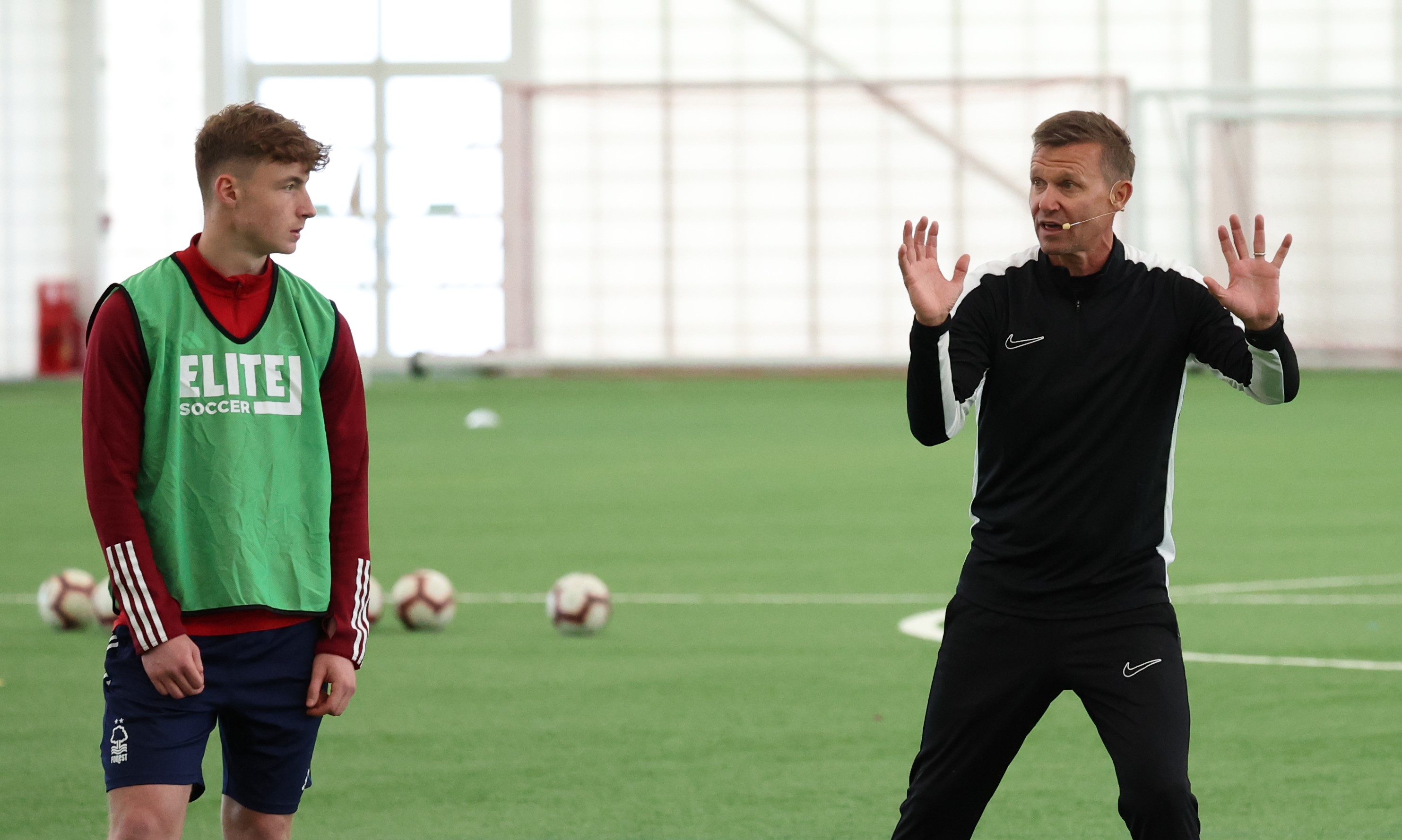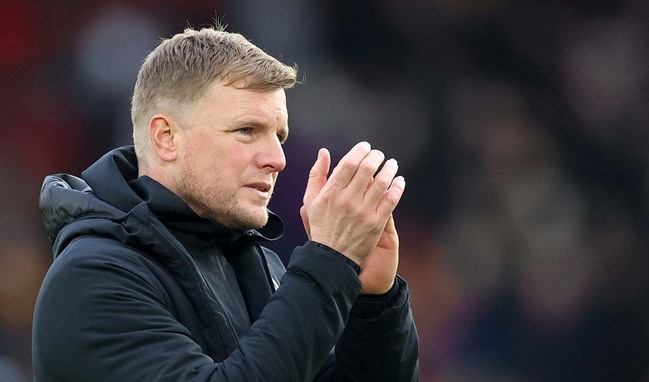




OUR BEST EVER OFFER - SAVE £100/$100
JOIN THE WORLD'S LEADING PROFESSIONAL DEVELOPMENT PROGRAMME
- 12 months membership of Elite Soccer
- Print copy of Elite Player & Coach Development
- Print copy of The Training Ground
You are viewing 1 of your 1 free articles
Pressing from the front
This session is designed to improve the defensive structure and behaviours of the team when the ball is wide through realistic games situations.
| Area | Up to full pitch |
| Equipment | Ball, bibs, cones, 2 full size goals |
| No. of Players | Up to 22 players + 2 goalkeepers |
| Session Time |
Rondo: 12 mins Specific breakout rondo: 15 mins 11v11 breakout rondo: 15 mins 11v11 game: 30 mins |
This session is designed to improve the defensive structure and behaviours of the team when the ball is wide through realistic games situations. It also encourages and allows the team in possession to be able to play away from pressure to start a quick attack.
We start with a rondo which encourages key behaviours when pressing and the composure to play away from pressure. We then move on to a situational phase of play, in which players must retain the ball in an area before breaking out. This is followed by a similar exercise which breaks out into a full 11v11. We finish with three ten-minute blocks of an 11-a-side game.
This session helps reinforce the idea of closing a player from all sides when trapped wide, then not only tackling, but winning the ball in a way that allows them to find a pass away from pressure. It also allows players to practice in position and on parts of the pitch they would regularly find themselves. This session is key to our game model. It can also be used as a physical hit with a particular focus on the explosive metrics such as high-speed running (HSR).
This is a session that we would repeat several times a month, tweaking it as needed depending on the opponent or on situations we need to practice based on our technical and tactical debriefs.
We would run the session earlier in the week when we look to train the more explosive elements of our game model in preparation for the upcoming match. The nature and randomness of the practices means all players can achieve multiple learning and physical outcomes. They must always be fully engaged to react.
RONDO
We set up a playing area of 18x18 yards, split into four 9x9 yard boxes. We’re using 12 outfield players split into three teams of four. The four red players start in one box, along with two blue players. The other two blue players rest in the middle of the area. The four yellow players are spread across the three remaining boxes.
Play starts with the red team. The team must make four passes before they are able to switch the ball to a yellow player in an adjacent area, as shown [1a].
[1a]
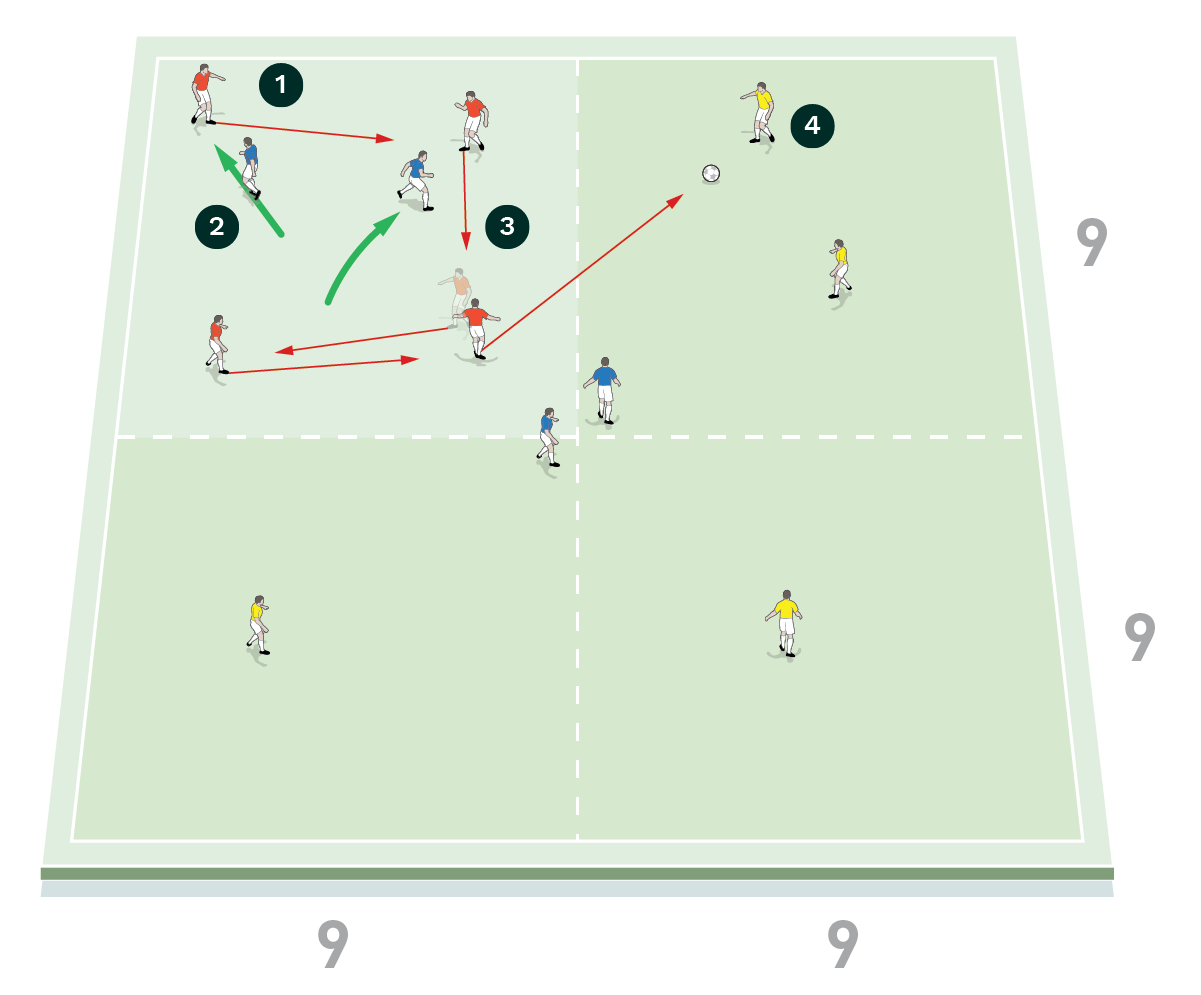
-
The ball starts with the red team
-
The blue players press the ball, attempting to win it back
-
The red team make four consecutive passes
-
The red team then switch the ball to a yellow in an adjacent area
The rest of the yellow team sprints to the square to join their teammate in possession of the ball. The two resting blues come into the square to press the ball while blues that had just pressed go to the middle. The red team spread out across the other boxes, as shown [1b].
[1b]
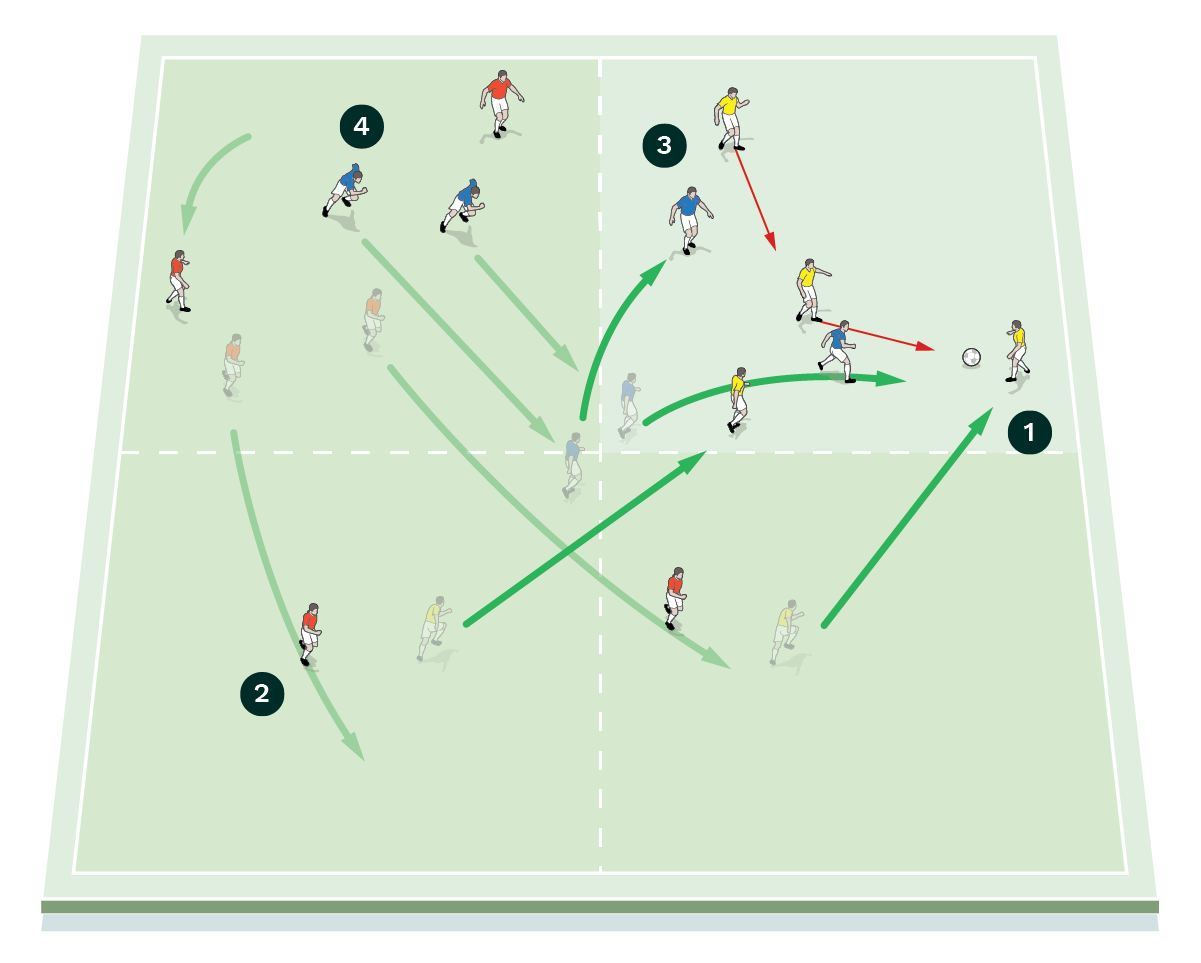
-
The yellows join their teammate in the area with the ball
-
The red team spread out around the other areas
-
The two blues in the middle go to press the ball
-
The two blues that had been pressing go to the middle to rest
The yellow team must look to make at least four passes before switching the ball to a red player. For the blue team to become a possession team, they must either force three mistakes, or win the ball and switch it to the resting team, in this case the yellows, as shown [1c].
[1c]
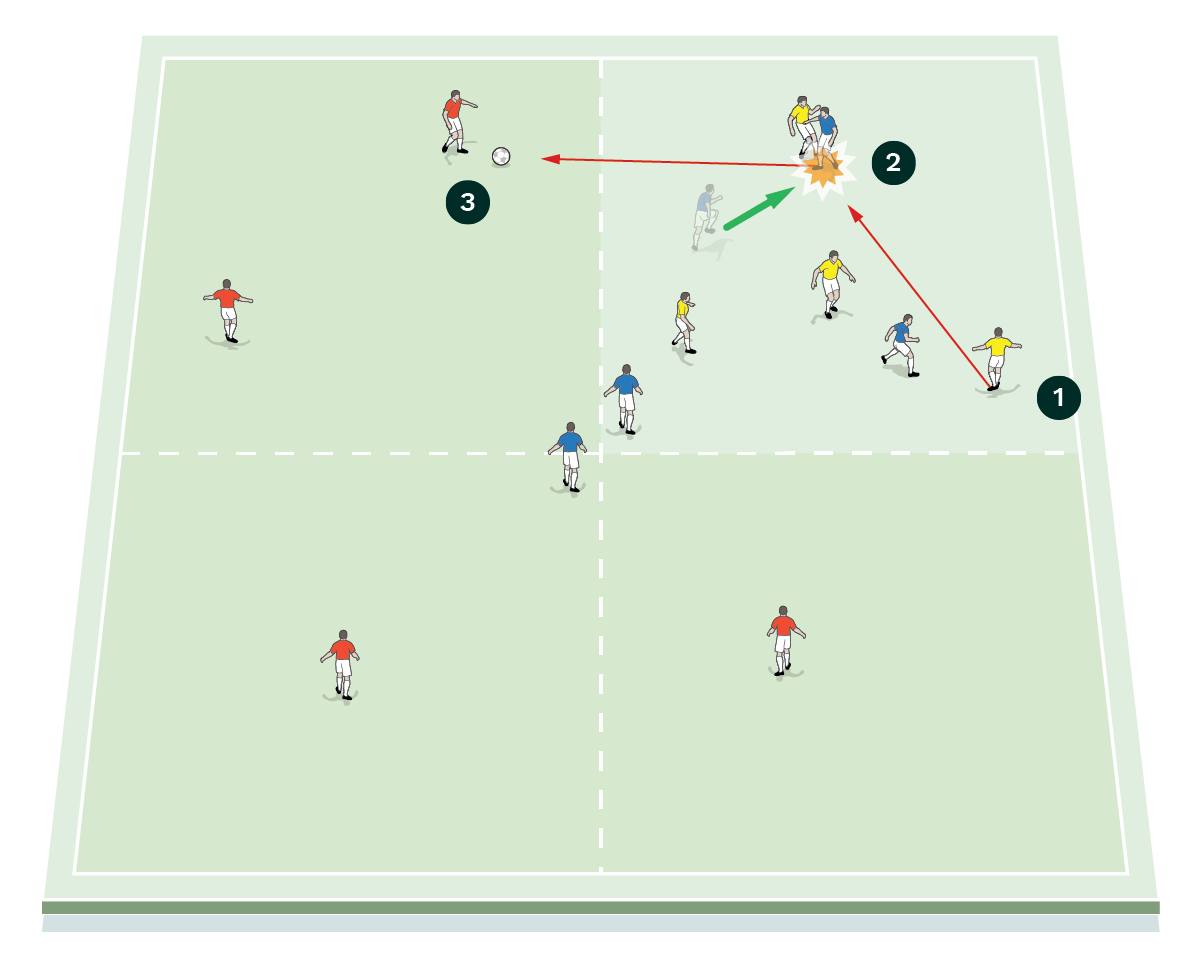
-
The yellow team look to make four consecutive passes
-
The blue team win the ball from their press
-
The blue player plays the ball to a red player in another area, allowing the blue team to become a possession team
We would play four sets of three minutes, so each team has a chance to start as the resting team.
SPECIFIC BREAKOUT RONDO
We set up on a full pitch. There is a full size goal and a goalkeeper positioned at each end. We mark out two boxes of 7x7 yards on either side of the centre circle, each seven yards in from the sideline. We’re using two full teams of 11.
Four members of the blue team start in one box – a fullback, two defensive midfielders and an attacking midfielder. They are joined by two reds – a full back and an attacking midfielder.
In the other box, there are four red players and two blue players – the same positions as in the other box.
On the rest of the pitch, each team has two centre backs, one attacking midfielder, and two strikers in set positions.
The practice runs on both sides, alternating after every play. Each round starts with a coach passing or throwing the ball in to the team of four.
The practice starts with the box with the blue overload. The coach plays the ball into a blue player. The blue team must then make three passes before they can transfer it out of the area to their attacking midfielder, as shown [2a].
[2a]
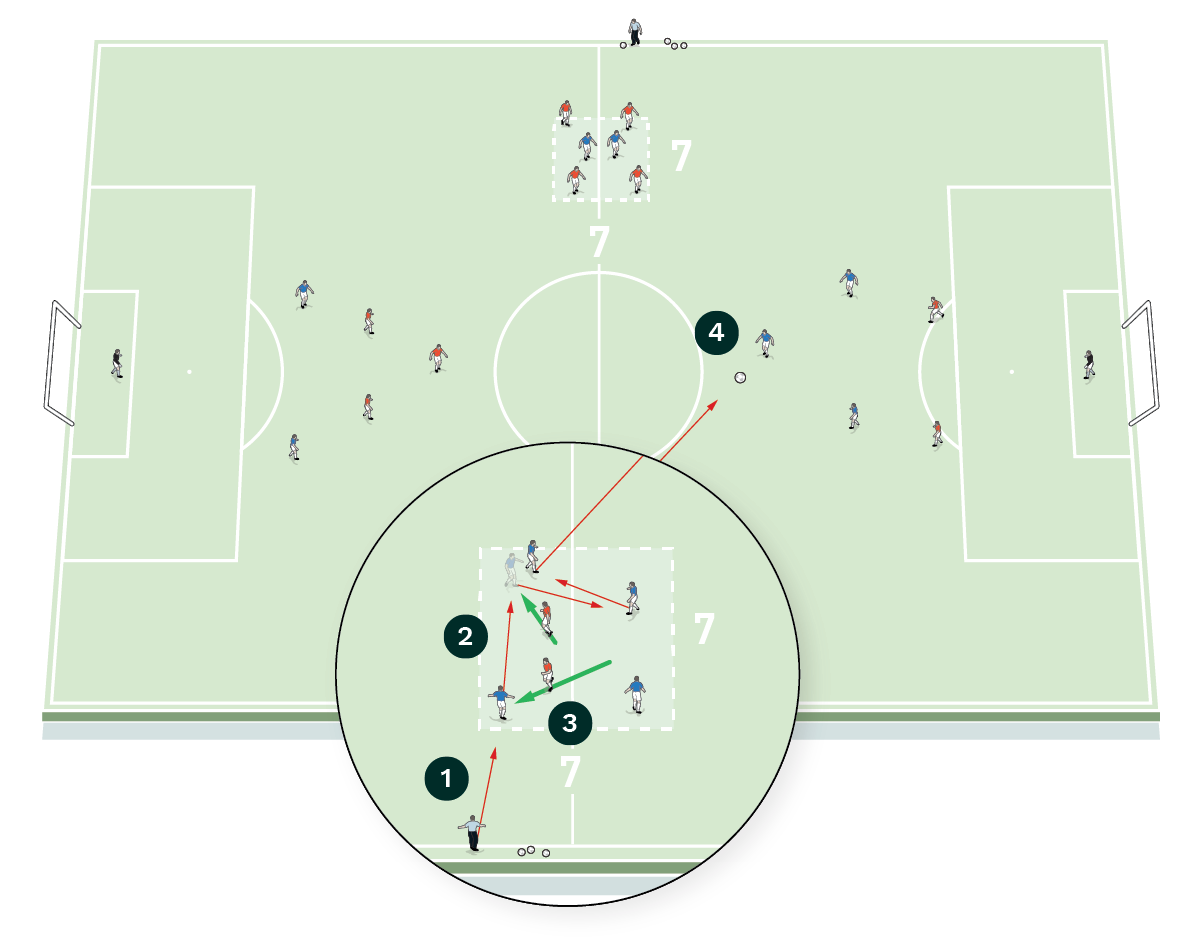
-
The coach plays the ball in
-
The blue team makes three passes
-
The red team press to win the ball back
-
The blues transfer the ball out of the area, playing it to their attacking midfielder
All players from the box can join in. The blue players support the attacking midfielder and two strikers in the attack, while the red players support the centre backs in defence. The blue team gain a point by scoring a goal, as shown [2b].
[2b]
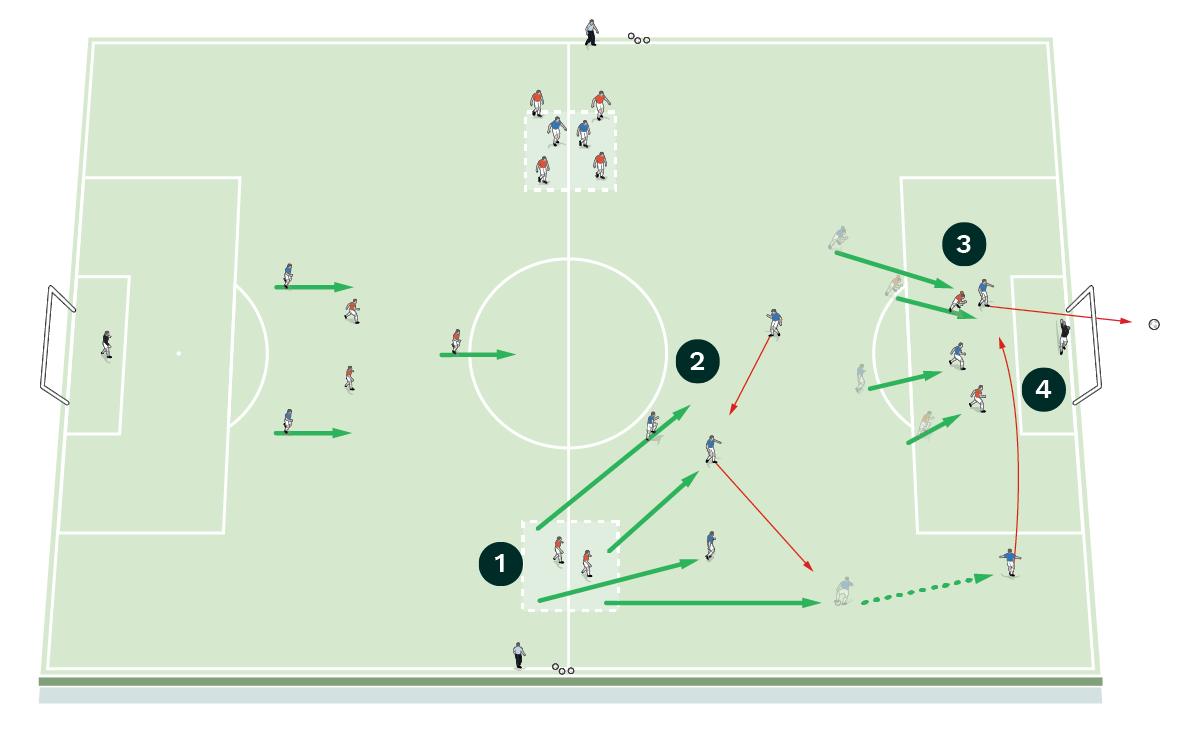
-
All players from the box join in with the game
-
The blue players support the attacking midfielder and two strikers in the attack
-
The red players support the centre backs in defence
-
The blue team scores a goal to gain a point
Once a goal has been scored or the ball has gone dead, players reset and play restarts from the coach on the other side, who plays the ball into a red player in the box. The reds aim to make three passes before transferring it out of the area.
If the blues win the ball back, they must get the ball to one of their attackers outside of the box. All players from the box can then join in as the blues look to score a goal, as shown [2c].
[2c]
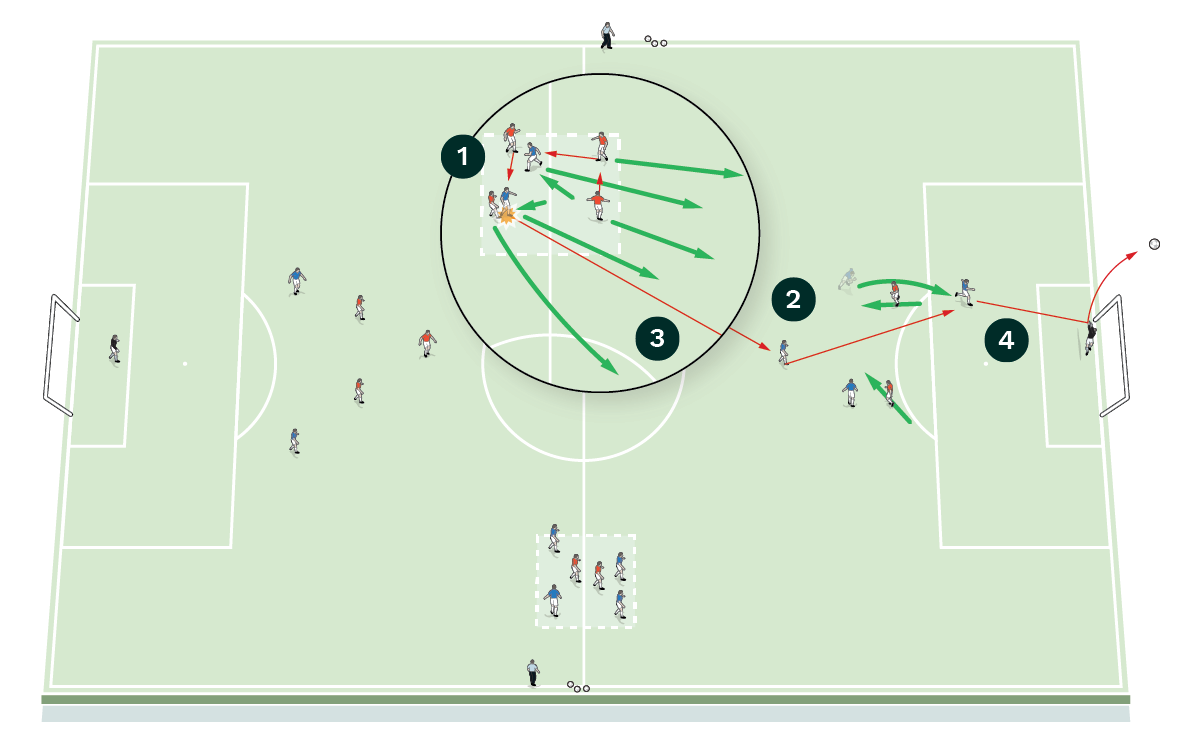
-
The blues win the ball back
-
The blue player plays the ball to an attacker outside of the box
-
All players from the box join in
-
The blue team scores a goal to gain a point
We would run this session for 15 minutes, allowing for between six and eight attacks on either side.
11V11 BREAKOUT RONDO
We set up on a full pitch. There is a full size goal and a goalkeeper positioned at each end. We mark out an area of 18x12 yards on each side of the pitch, in the middle. We’re two full teams of 11 plus two neutral players.
Play starts in one of the boxes. There are four blues and four reds in the box – with two full backs, a defensive midfielder and an attacking midfielder per team – alongside two neutral players, the yellows.
Each round starts with a coach passing or throwing the ball into a box. The team in possession must make four passes, and can combine with the neutral players to do so, before transferring the ball to an attacker outside of the box, as shown [3a].
[3a]
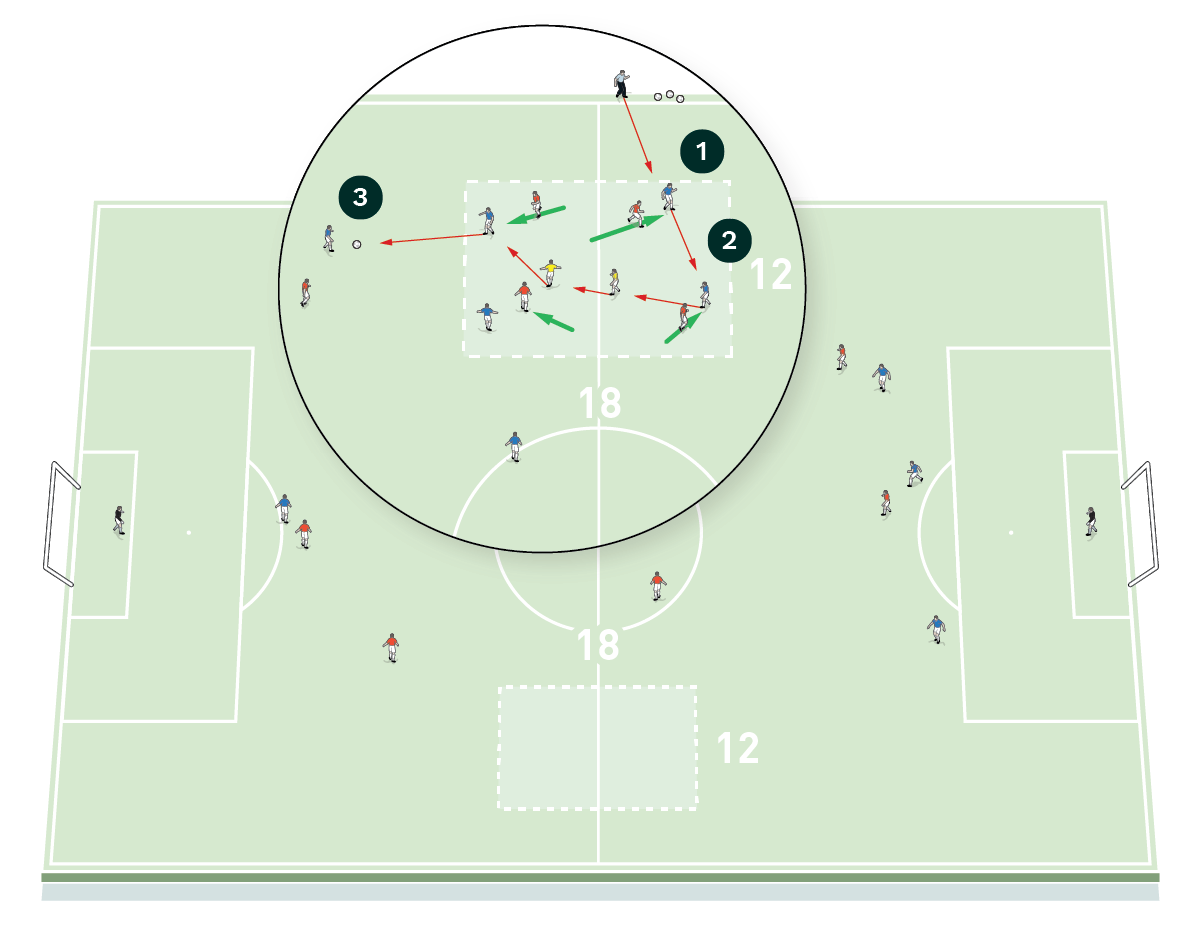
-
The coach plays the ball into a blue player in the box
-
Blues and the two neutrals combine to make four passes
-
The blue player then transfers the ball to an attacker outside of the box
All players from the box can join in, making it a full 11v11. The blue team gain a point by scoring a goal, as shown [3b].
[3b]
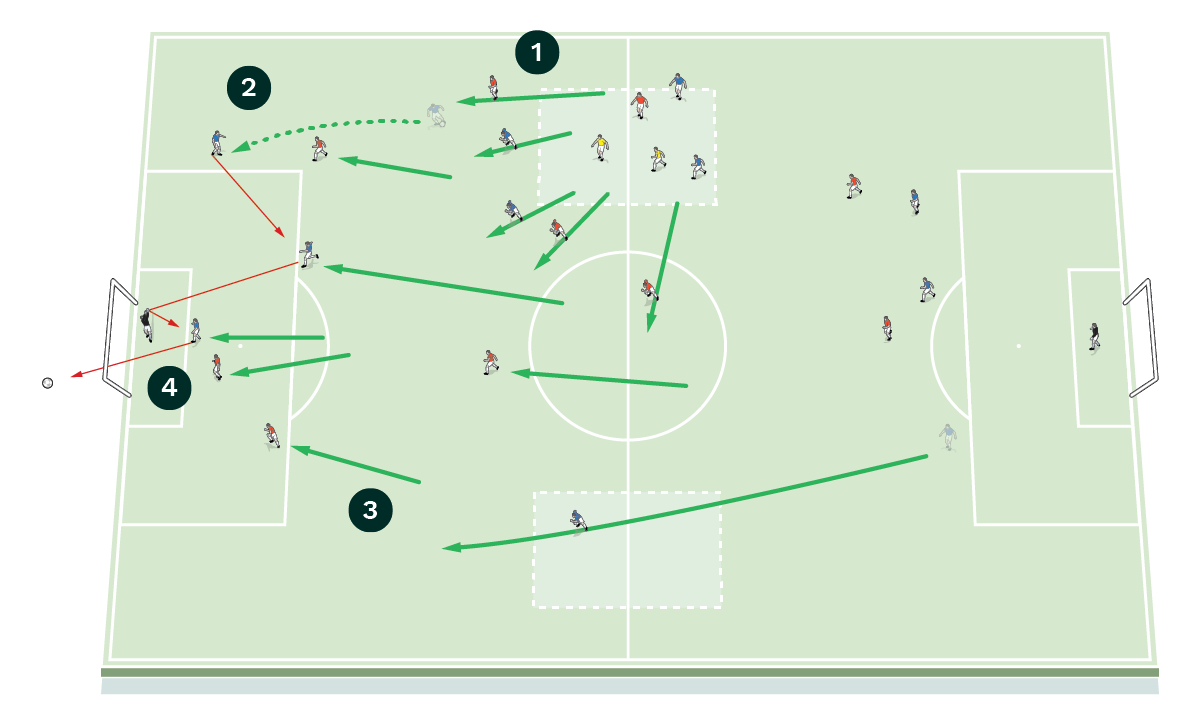
-
All players join in, making it an 11v11
-
The blue team attack
-
The red team get back to defend
-
The blue team score a goal to win a point
Once a goal has been scored or the ball has gone dead, players reset, this time in the box on the other side. The coach plays the ball into the box. The red team must make four passes before playing a ball to their attacker. If the blues win the ball back, they must get the ball to one of their attackers outside of the box. All players from the box can then join in as the blues look to score a goal, as shown [3c].
[3c]
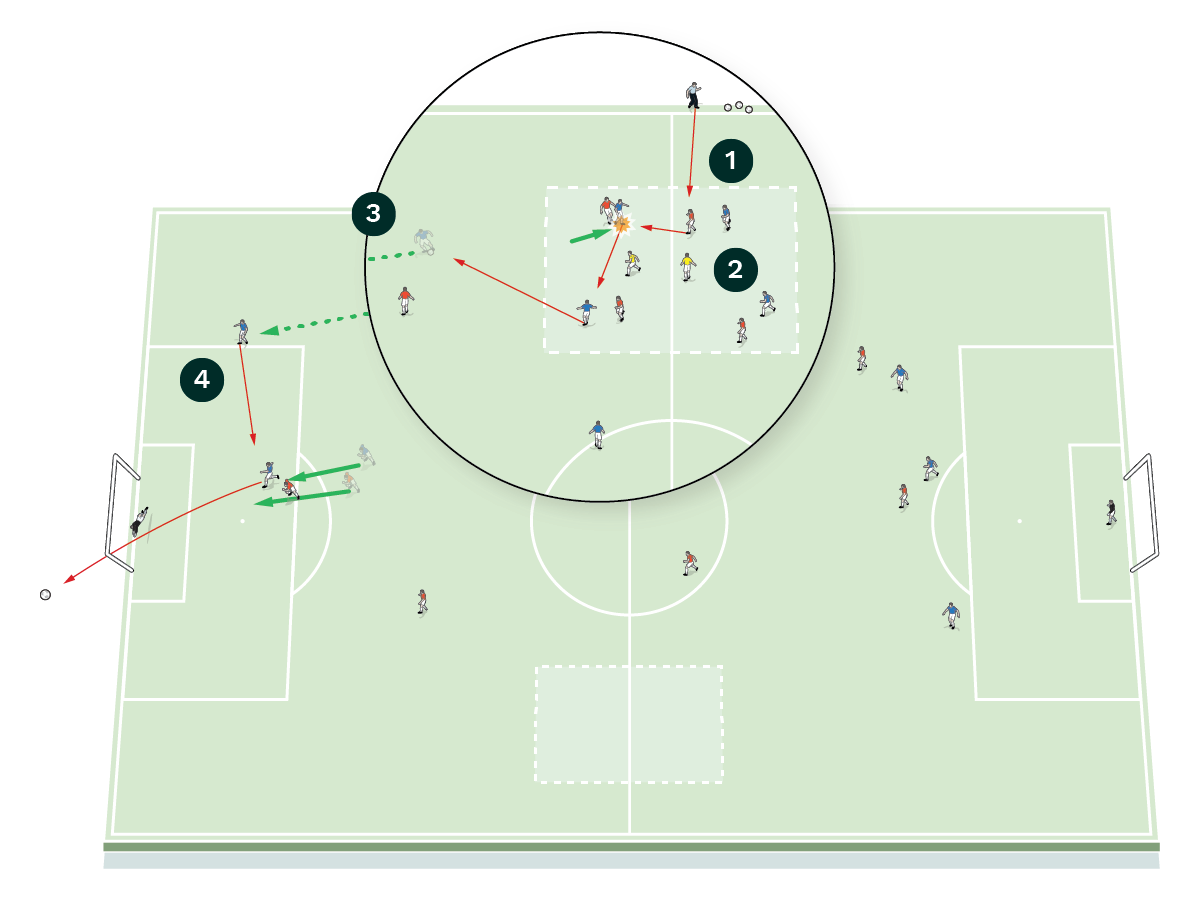
-
The coach plays the ball into the box
-
The red team look to make four passes before playing a ball to their attacker
-
The blues win the ball back and play it to one of their attackers outside of the box
-
All players join in, making it an 11v11
We would run this session for 15 minutes, allowing for between six and eight attacks on either side.
This practice is the most crucial of the three as it allows me to see if players close properly when the ball goes wide. Attacking midfielders should close from the front to ensure pressure from both sides with the fullback on the jump. If this doesn’t happen, starting the 11v11 with a pass from the full back to wide players will allow this repetition.
We then go into an unrestricted 11v11, which we play for three blocks of 10 minutes.
What are the key things to look out for?
Throughout the session, in order to win the ball back, the out of possession team is asked to:
- Achieve maximum intensity to speed up the in-possession team and force mistakes. The quicker they play, the less time they have to get their head up or pass with detail and quality.
- Make the last step. The closer a defender gets, the bigger the shadow and fewer options the player has in possession.
- Go to the ball to create a defensive overload where the opposition player is pressed from two sides in a 2v1.
- Tackle to keep the ball. Can you take the ball off an opponent rather than kick it off the pitch? Or toe the ball away for a team mate to be able to play forward quickly?
Once the ball has been won, the team is asked to:
- Find attacking team mates, or team mates stood away from the point of regain. Because of the game model and positional play, players should know where the attackers are positioned.
- Pass with pace and in front of the attacker to speed the attack up, restricting the defending team’s time to recover.
What are the typical mistakes players might make and how can they be avoided?
It’s common to see technical errors in this session. Because the practices are so quick, helping players with pass appreciation, particularly on regaining the ball, and knowing where to put the ball on first touch is critical.
Players will also show disappointment when losing the ball and therefore won’t engage in a counter press. Training the counter press is a key behaviour which is fundamental to the way I want to play. A strong counter press is always a goalscoring opportunity as the opponents open their shape in order to keep the ball.
Help and support from across the team when reacting to losing the ball will be essential for the coaching staff to explain and highlight good no disappointment behaviours.
Players away from the ball must be switched on and ready to react to a turnover, either to come out of the shadows to receive, or to quickly close down to stop counter attacks.
Related Files

David Horseman
Editor's Picks
Attacking transitions
Deep runs in the final third
Using the goalkeeper in build-up play
Intensive boxes drill with goals
Penetrating the final third
Creating and finishing
My philosophy
Pressing initiation
Compact team movement
Coaches' Testimonials

Alan Pardew

Arsène Wenger

Brendan Rodgers

Carlos Carvalhal

José Mourinho

Jürgen Klopp

Pep Guardiola

Roy Hodgson

Sir Alex Ferguson

Steven Gerrard
Coaches' Testimonials

Gerald Kearney, Downtown Las Vegas Soccer Club

Paul Butler, Florida, USA

Rick Shields, Springboro, USA

Tony Green, Pierrefonds Titans, Quebec, Canada
Join the world's leading coaches and managers and discover for yourself one of the best kept secrets in coaching. No other training tool on the planet is written or read by the calibre of names you’ll find in Elite Soccer.
In a recent survey 92% of subscribers said Elite Soccer makes them more confident, 89% said it makes them a more effective coach and 91% said it makes them more inspired.
Get Monthly Inspiration
All the latest techniques and approaches
Since 2010 Elite Soccer has given subscribers exclusive insight into the training ground practices of the world’s best coaches. Published in partnership with the League Managers Association we have unparalleled access to the leading lights in the English leagues, as well as a host of international managers.
Elite Soccer exclusively features sessions written by the coaches themselves. There are no observed sessions and no sessions “in the style of”, just first-hand advice delivered direct to you from the coach.





